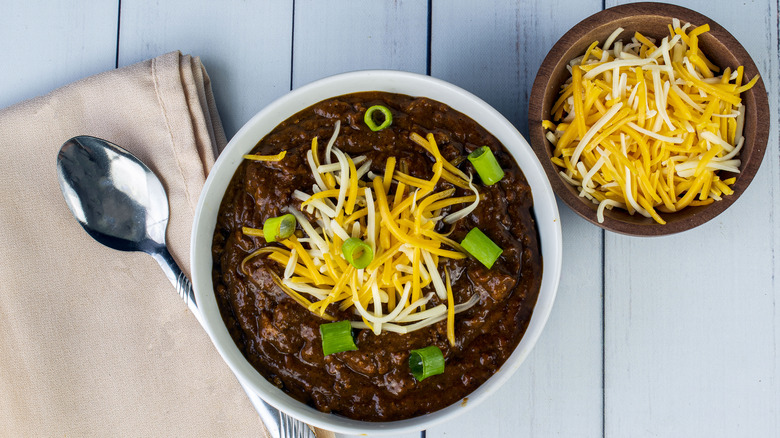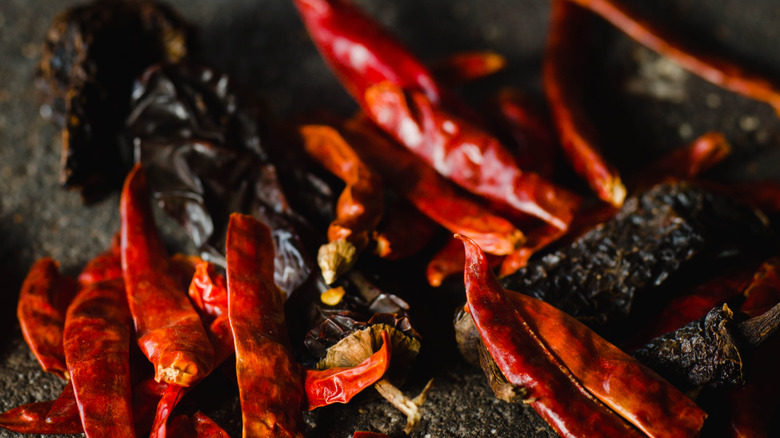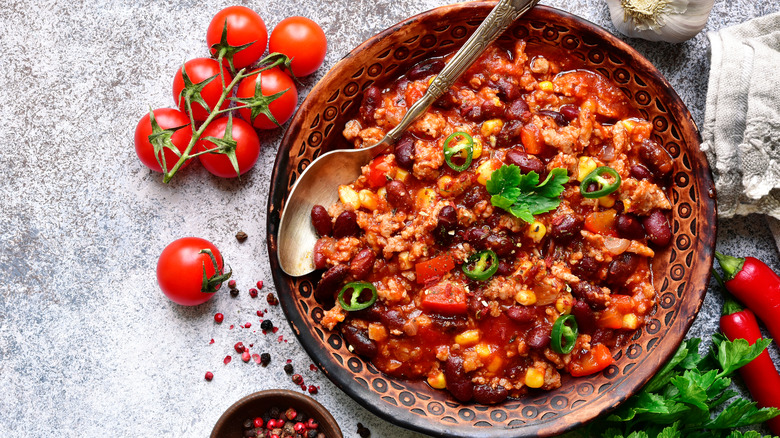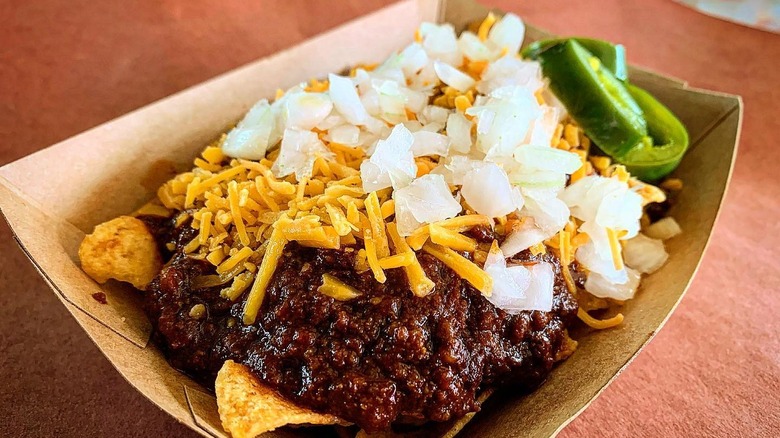The Controversial Ingredient In Texas Chili
Without a doubt, Texans have strong opinions on chili, the official state dish since 1977. Records from the Legislative Reference Library of Texas attribute the origin of the dish, known as a bowl of red, to 1830s San Antonio, and reference a firm opinion from former president and Texas native Lyndon B. Johnson, who said, "Chili concocted outside of Texas is a weak, apologetic imitation of the real thing."
It seems that the prevailing theory is that chili evolved from Mexican-style chile con carne – meat stewed in chili pepper sauce. But chili also bears a strong resemblance to chile Colorado, a deep red, Mexican beef stew that hails from Chihuahua, a state that borders present-day Texas.
Regardless of its origins, one thing is certain: Texans say beans have no place in chili. The International Chili Society, which runs the World Championship Chili Cook-Off, says, "Traditional Red Chili is any kind of meat, or combination of meats, cooked with red chili peppers, various spices, and other ingredients. Beans and non-vegetable fillers such as rice and pasta are not allowed." Texas chili includes nothing more than beef (typically cubed or diced rather than ground), a puree of dried whole chilies (not chili powder), garlic, onion, stock or water, seasonings like cumin and oregano, and a bit of masa harina to thicken the mix.
What is the history of Texas chili?
The different legends of how chili came to be range from a Spanish nun who would regularly astral project into the Americas and returned to her body after one such trip with a recipe for chili made from luckless conquistadors, tomatoes, and peppers to a group of Texas settlers from the Canary Islands who brought a cumin-spiced Moroccan-influenced stew. Others say it was the cowboys who rehydrated dried beef pounded with chilies and salt who made chili what it is — or that the chili actually evolved from indigenous tribal recipes.
The first printed mention of the dish wasn't until 1882, around the time when journalists wrote pieces about the ladies who came to be known as the Chili Queens. These women set up stands in the San Antonio Military Plaza to sell bowls of the piquant stew to hungry soldiers and workers.
It is reasonable to assume that some version of chili has existed for much longer, but perhaps the lack of written record means that chili previously went by another name.
How did beans end up in chili?
Beans have long been found in or alongside chili, but are typically regarded by Texans and chili purists as a filler — beans have utility, but have never been the star. Texas chili should be focused on high-quality beef and spicy, fruity, and flavorful dried chilies. Some travelers who passed through San Antonio noted that beans did appear in early versions of chili con carne, but the Chili Queens more often served beans as a side dish as is common in Mexican cooking.
During long cattle drives through the plains, cowboys cooked a pot of beans separate from the chili. Beans were used to fill out the plate, and some mixing definitely would have happened over the course of a meal. Some argue that beans and other fillers like tomatoes actually made it into the chili pot as resources grew scarce.
The entrepreneurship of the San Antonio Chili Queens put chili on the map in the late 1800s. Cooks from San Antonio served their regional specialty at the 1893 World's Fair in Chicago, and before long chili stands were opening up across the United States. By the 1920s, some chili recipes called for beans; decades later, tomatoes became a common add-in.
A question of authenticity
While beans will never be considered traditional, they can be a part of chili as long it's not called Texas chili. Like many regional dishes, chili has grown to have a life of its own. Many simple versions combine ground meat, canned tomatoes, beans, and chili powder — a significant departure from the rich, slow-cooked, stew with fall apart cubes of beef. Others include bell peppers, tomatillos, pork, corn, green chilies, or vegetarian meat substitutes. A Tennessee white chili recipe includes chicken and great northern or cannellini beans. The International Chili Society even created a new Homestyle Chili category in 2012 that can include any vegetables or seafood; It does not have to be red in color but must include beans.
While Texans and everyone else may not be able to agree as to what should go inside chili, toppings are definitely allowed. Sour cream, shredded cheddar cheese, pickled or fresh jalapeños, tomatoes, diced white onion, scallions, avocado, or a wedge of lime can all adorn a bowl of chili. Serve alongside saltine crackers, cornbread, or fresh tortillas, or in true Texas fashion, cut open a bag of corn chips and spoon in some chili for Frito Pie – another iconic dish Texans will gladly go to bat for.




